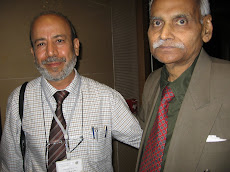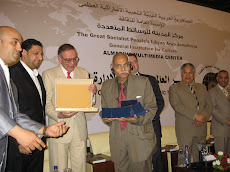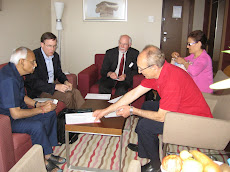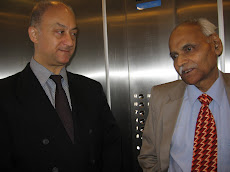List: 2005 Top Ten Book Reviewers at Amazon.com
_____________________________________________________________________
1.Harriet Klausner (9,024) (56,245)
2.Lawrance M. Bernabo (The Zenith City: Duluth, MN United States)
(10,175 ) (55,935)
3.Donald Mitchell (2,599) (41,963)
4.Rebecca Johnson (2,773) (21,700)
5.Gail Cooke (TX, USA) (2,738) (16,534)
6.Joanna Daneman (Middletown, DE USA) ((1,1756) (20,022)
7.Barron Laycock (Temple, New Hampshire United States) (1,136) (31,
008)
8.Marc Ruby (Warren, MI USA) (1,320) (15,750)
9.E. A Solinas "ea_solinas" (MD USA) (2,275) (17,246)
10. Robert Morris (Dallas, Texas) (1,180) (12,579)
_____________________________________________________________________
Note: 1. Figures in first parentheses indicate the number of reviews
while the figures in second parentheses indicate the number of
helpful votes.
Source: Top Reviewrs, http://www.amazon.com/o/tg/cm/top-reviewers-
list/-/1/ref=cm_xx_hp_rev/104-3004000-7881534
Dr D.C.Misra
May 30, 2005
Monday, May 30, 2005
Books: Latest Arrivals: Eggers (2005):Government 2.0
Books: Latest Arrivals: Eggers, William D. (2005): Government 2.0: Using Technology to Improve Education, Cut Red Tape, Reduce Gridlock, and Enhance Democracy, Lanham, MD, Rowman and Littlefield, January ,304 pp, Cloth 0-7425-4175-4 $27.95
Check it at
http://www.rowmanlittlefield.com/Catalog/SingleBook.shtml?
command=Search&db=^DB/CATALOG.db&eqSKUdata=0742541754
Dr D.C.Misra
May 30, 2005.
Check it at
http://www.rowmanlittlefield.com/Catalog/SingleBook.shtml?
command=Search&db=^DB/CATALOG.db&eqSKUdata=0742541754
Dr D.C.Misra
May 30, 2005.
Website Watch: Policypointers
Policypointers is "an online facility created to enable those involved in government, academe and the media to gain rapid access to the research and conclusions of think tanks around the world." It believes that "policymakers and those who influence the policymaking function can frequently learn from the research done and the results achieved in countries other than their own. This belief is the rationale for creating this website." Though the site claims to be independent,it does not give its source of funding. Check it at
http://www.policypointers.org/page_4.html
Dr D.C.Misra
May 30, 2005
http://www.policypointers.org/page_4.html
Dr D.C.Misra
May 30, 2005
Books: Latest Arrivals: Goldsmith and Eggers (2004): Governing by Network
Books: Latest Arrivals: Goldsmith, Stephen and William
D.Eggers (2004): Governing by Network: The New Shape of the Public
Sector, Washington, D.C., Brookings Institution Press.
Copublished with Innovations in American Government, John F. Kennedy
School of Government, Harvard University.
c. 224pp, Cloth Text, 0-8157-3128-0, $44.95, Paper Text,
0-8157-3129-9, $18.95, Check details at
http://www.brookings.edu/press/books/governingbynetwork.htm
Dr D.C. Misra
May 30, 2005
D.Eggers (2004): Governing by Network: The New Shape of the Public
Sector, Washington, D.C., Brookings Institution Press.
Copublished with Innovations in American Government, John F. Kennedy
School of Government, Harvard University.
c. 224pp, Cloth Text, 0-8157-3128-0, $44.95, Paper Text,
0-8157-3129-9, $18.95, Check details at
http://www.brookings.edu/press/books/governingbynetwork.htm
Dr D.C. Misra
May 30, 2005
Wednesday, May 25, 2005
Who benefits more from eGov: Public authorities or citizens?
Public authorities. This is one of the findings of an important study* commissioned by European Union and carried out by Capgemini, Netherlands and TNO-Strategy, Technology and Policy, in its final report, final version.
The objective of the study was "to investigate if it is worth investing in eGovernment initiatives, and to identify the back office changes required for that." The study selected and studied in detail eight European exemplary public services ("eurexemps") from Denmark, Estonia, Finland, France, Germany, the Netherlands, Slovenia and Spain. The conclusion of the study is that "eGovernment does pay off and that back office changes are required to achieve
results."
The returns on e-government have been divided into seven categories:
1. Improved quality of information and information supply, 2. Reduction of process time, 3. Reduction of administrative burdens, 4. Cost reduction, 5. Improved service level, 6. Increased efficiency; and 7. Increased customer satisfaction. These seven returns are interconnected. The study is wound up by making a number of recommendations.
The results of the case studies show that "the use of ICT in the public sector can indeed be rewarding. All case studies show different degrees of improved service delivery (more digitised information, more transparency, more flexibility, faster delivery), and a reduction of transaction costs (reduction of process time,
saving on costs, more efficiency and -especially for businesses- a reduction of administrative burdens)."
The study also reports "different returns for customers on the one hand, and governmental/public authorities on the other hand: the public authorities themselves appear to benefit most from investments in e-government." The most striking result of this study, according to the report, "is that quick wins in particular can be obtained relatively easily, that is, without fundamental
organisational changes."
Dr D.C.Misra
May 25, 2005.
______________________________________________________________________
*European Public Administration Network (EPAN) (2004): Does E-
Government Pay Off? Capgemini, Netherlands and TNO- Strategy, Technology and Policy, Final report, Final version, December 6, 55 pp, available:
http://www.eupan.org/cms/repository/document/Does_e_gov_pay_off.zip
The objective of the study was "to investigate if it is worth investing in eGovernment initiatives, and to identify the back office changes required for that." The study selected and studied in detail eight European exemplary public services ("eurexemps") from Denmark, Estonia, Finland, France, Germany, the Netherlands, Slovenia and Spain. The conclusion of the study is that "eGovernment does pay off and that back office changes are required to achieve
results."
The returns on e-government have been divided into seven categories:
1. Improved quality of information and information supply, 2. Reduction of process time, 3. Reduction of administrative burdens, 4. Cost reduction, 5. Improved service level, 6. Increased efficiency; and 7. Increased customer satisfaction. These seven returns are interconnected. The study is wound up by making a number of recommendations.
The results of the case studies show that "the use of ICT in the public sector can indeed be rewarding. All case studies show different degrees of improved service delivery (more digitised information, more transparency, more flexibility, faster delivery), and a reduction of transaction costs (reduction of process time,
saving on costs, more efficiency and -especially for businesses- a reduction of administrative burdens)."
The study also reports "different returns for customers on the one hand, and governmental/public authorities on the other hand: the public authorities themselves appear to benefit most from investments in e-government." The most striking result of this study, according to the report, "is that quick wins in particular can be obtained relatively easily, that is, without fundamental
organisational changes."
Dr D.C.Misra
May 25, 2005.
______________________________________________________________________
*European Public Administration Network (EPAN) (2004): Does E-
Government Pay Off? Capgemini, Netherlands and TNO- Strategy, Technology and Policy, Final report, Final version, December 6, 55 pp, available:
http://www.eupan.org/cms/repository/document/Does_e_gov_pay_off.zip
Friday, May 13, 2005
Review of Bannister (2004): Deep E-Government
Frank Bannister* of Trinity College, Dublin, is critical of benchmarking e-government stating that “Many of the benchmarks on the list use facile or superficial metrics such as the percentage of GDP spent on e-government, the number of on-line services for citizens or the percentage of citizens that have visited a government web site.” In his view “Much of what is described as e-government is indeed superficial” and “Much of what is not superficial is not considered to be e-government.” He therefore advances the concept of “Deep E-Government” concerned with “ the core functions of government and of administration.” Proposing an “onion model” of e-government and stating that “deep e-government” is concerned with the three inner layers of administrative core, agencies and government (the other two layers being “wider public” and “commercial sector”), his conceptualization of e-government encompasses two types of deep e-government: (i) Transformative e-government and (ii) End-to-end e-government.
Illustrated with practical examples, he is of the view that “the type of deep and more reflective discussion that is to be found in the informatization literature of the 1980s and 1990s seems to have been overwhelmed by discussions of such things as how to improve web-site effectiveness, measure e-government penetration or bridge the digital divide.” Accordingly he makes a call for “more consideration of(or even a return to!) deeper conceptual issues and for innovative thinking about how the nature of governance itself can be moderated by technology.” He has proposed several lines of enquiry and his recommendation that “we need to move beyond the web sites and regain an historical and holistic perspective” will find many supporters, including this reviewer. A very well written and thought-provoking contribution, any one interested in e-government will benefit by reading it, and perhaps more importantly, thinking over various issues so very pertinently raised by Bannister.
Dr D.C.Misra
New Delhi, India
May 13, 2005.
_____________________________________________________________________________________
*Bannister, Frank (2004): Deep E-Government, EGPA 2004 Annual Conference, September 1-4, 2004, Ljubljana, Slovenia, available: http://www.fu.uni-lj.si/egpa2004/html/sg1/Bannister.pdf (accessed: May 13, 2005).
Illustrated with practical examples, he is of the view that “the type of deep and more reflective discussion that is to be found in the informatization literature of the 1980s and 1990s seems to have been overwhelmed by discussions of such things as how to improve web-site effectiveness, measure e-government penetration or bridge the digital divide.” Accordingly he makes a call for “more consideration of(or even a return to!) deeper conceptual issues and for innovative thinking about how the nature of governance itself can be moderated by technology.” He has proposed several lines of enquiry and his recommendation that “we need to move beyond the web sites and regain an historical and holistic perspective” will find many supporters, including this reviewer. A very well written and thought-provoking contribution, any one interested in e-government will benefit by reading it, and perhaps more importantly, thinking over various issues so very pertinently raised by Bannister.
Dr D.C.Misra
New Delhi, India
May 13, 2005.
_____________________________________________________________________________________
*Bannister, Frank (2004): Deep E-Government, EGPA 2004 Annual Conference, September 1-4, 2004, Ljubljana, Slovenia, available: http://www.fu.uni-lj.si/egpa2004/html/sg1/Bannister.pdf (accessed: May 13, 2005).
Subscribe to:
Comments (Atom)





























